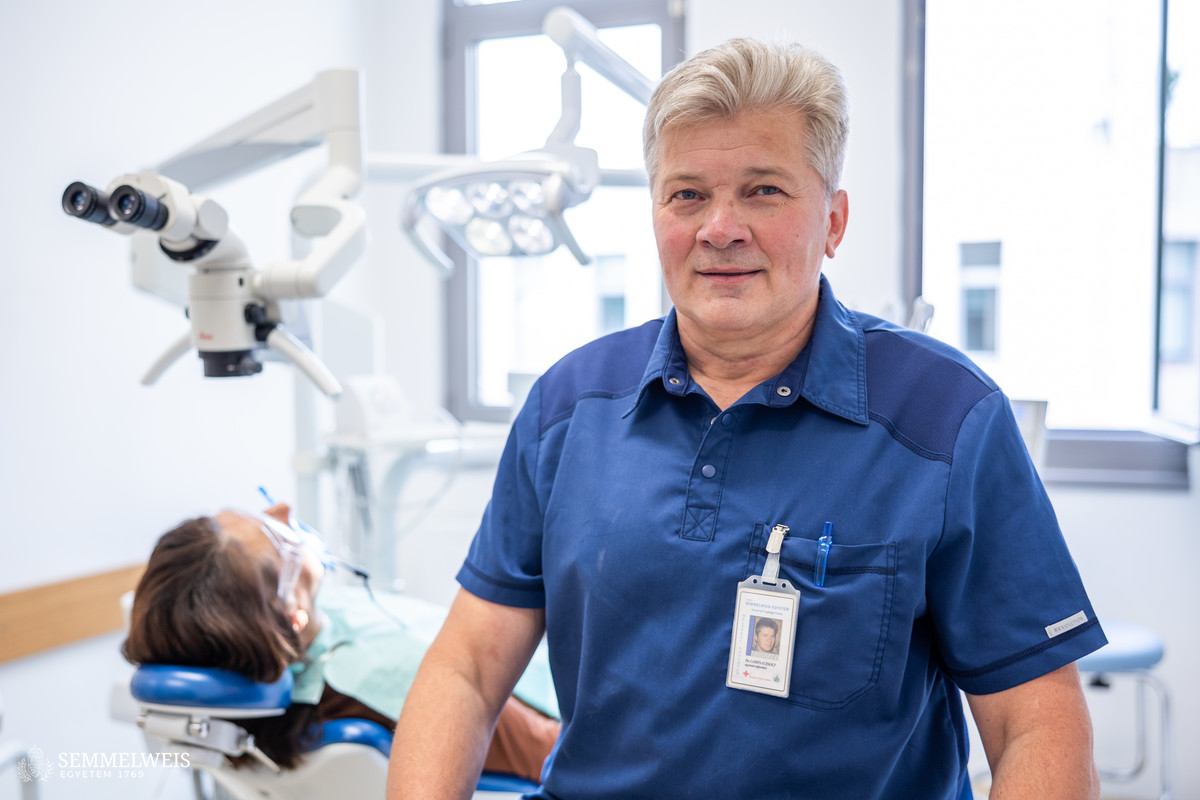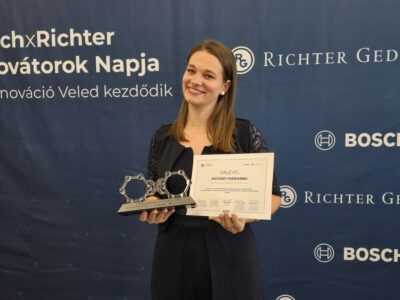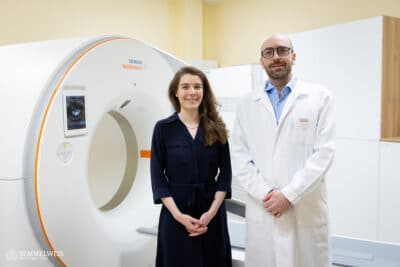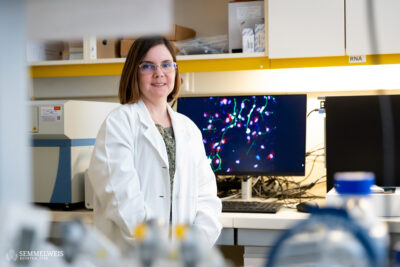“I graduated from the Faculty of Dentistry of Semmelweis University of Medicine in 1987 and then started working at the Department of Clinical Experimental Research and Human Physiology, one of the predecessors of the Institute of Translational Medicine. I was always attracted to research, but I also loved the practice of dentistry, so my goal was always to do scientific work that had practical applications,” Dr. Zsolt Lohinai recalled the beginning of his career. In 2006 he was appointed to the then Department of Conservative Dentistry, now known as the Department of Restorative Dentistry and Endodontics, where he still works. “In 2006, I modified my research approach a bit, shifting from looking at the body’s inflammatory, non-classical responses to researching bacterial mechanisms, and we tested potential oral rinse blockade of one of these pathways in a self-sponsored Phase II clinical trial, which led us down a bit of a circuitous route to our Innovation Award-winning insight,” he said.
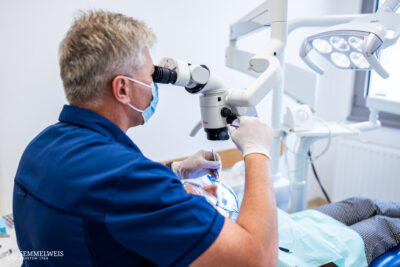 “We know that the end result of periodontal disease is the destruction of the supporting structure and of the gums, atrophy of the bone, loosening of the teeth, and eventually they fall out. But exactly how this develops, what the initial steps are when the true periopathogenic bacteria are not even present, is not really known. We had an idea for this, which we developed together with an American colleague, who laid the groundwork with in vitro experiments. I really liked his approach, which we developed further to investigate which components in the biofilm adhering to the tooth at the tooth neck destroy the epithelial barrier that seals the teeth from the outside world. We found some biofilm fractions that destroy the epithelial cells, and we tried to test them in human studies,” Dr. Zsolt Lohinai recalled. “It turned out that the plaque contains bacteria that have an enzyme called lysine decarboxylase on the outer cell wall, which converts an essential amino acid named lysine into cadaverine. As the body cannot produce lysine and bacteria use it up instead of the epithelial cells, a local lysine deficiency develops in the gums, causing the epithelial cells to synthesize inflammatory substances that increase the amount of gingival exudate. Although this compensates for the lysine deficiency, the large amount of inflammatory exudate that gets into the gingival groove around the teeth is an excellent nutrient for bacteria. Basically, we are indirectly inviting the bacteria living in our oral cavity to a buffet meal,” he concluded. They speculate that this could be the first potential step in the development of periodontitis.
“We know that the end result of periodontal disease is the destruction of the supporting structure and of the gums, atrophy of the bone, loosening of the teeth, and eventually they fall out. But exactly how this develops, what the initial steps are when the true periopathogenic bacteria are not even present, is not really known. We had an idea for this, which we developed together with an American colleague, who laid the groundwork with in vitro experiments. I really liked his approach, which we developed further to investigate which components in the biofilm adhering to the tooth at the tooth neck destroy the epithelial barrier that seals the teeth from the outside world. We found some biofilm fractions that destroy the epithelial cells, and we tried to test them in human studies,” Dr. Zsolt Lohinai recalled. “It turned out that the plaque contains bacteria that have an enzyme called lysine decarboxylase on the outer cell wall, which converts an essential amino acid named lysine into cadaverine. As the body cannot produce lysine and bacteria use it up instead of the epithelial cells, a local lysine deficiency develops in the gums, causing the epithelial cells to synthesize inflammatory substances that increase the amount of gingival exudate. Although this compensates for the lysine deficiency, the large amount of inflammatory exudate that gets into the gingival groove around the teeth is an excellent nutrient for bacteria. Basically, we are indirectly inviting the bacteria living in our oral cavity to a buffet meal,” he concluded. They speculate that this could be the first potential step in the development of periodontitis.
As Dr. Zsolt Lohinai explained:
It later turned out that there are basically two types of inflammatory gingival secretion responses that our body can give to bacterial overgrowth: weak and strong. The strong response is beneficial because it flushes bacteria and their products out of the gum furrow. The weak response is not able to do this, but because of its composition, it provides the bacteria with nutrients and incubates them, and thus the healthy flora in the saliva becomes constantly dysbiotic due to the nutrient changes, turning pathogenic and causing pocketing.
He pointed out that by studying the responses, they found that DNA analysis of single nucleotide polymorphisms could be used to determine whether a strong or weak response is typical of a given individual. And if we can determine this genetically, we will know who is prone to periodontitis, even after birth, long before the first symptoms develop, he emphasized.
Dr. Zsolt Lohinai said that early detection of periodontal disease was very important because it was a painless disease, patients often only noticed it when their gums were atrophying and their teeth started to loosen. Because of atrophied gums, a palm-sized scar can form in the mouth around the teeth with virtually no symptoms, through which bacteria, toxins, and other metabolites can enter the deeper tissues from the oral cavity through the bloodstream and cause consequential diseases, he underlined.
He added that there was a lot of ongoing research on this, but it seemed certain that bacteria and their products that entered through the gingiva contributed to the development of many diseases, such as cardiovascular diseases, arthritis, diabetes, premature birth, tumors, and even Alzheimer’s disease. In other words, efforts to prevent periodontal disease are by no means only about the health of our teeth, but they also greatly support the early prevention of life-ending diseases and diseases that worsen the elderly’s quality of life, he said.
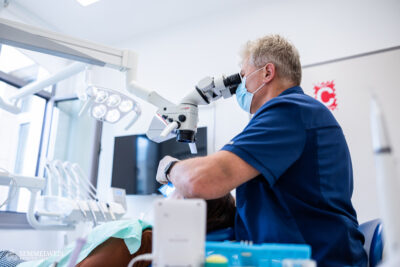 The Innovation Award-winning DNA test is currently in the clinical phase. Dr. Zsolt Lohinai said that ethical clearance is being sought for a larger population trial to investigate the association between periodontitis and the genetic profiles mentioned; they would also investigate the percentage of Alzheimer’s patients with inflammatory responses associated with different single nucleotide polymorphism profiles. He and his American colleague and research team would also like to create a DNA chip so that simplified profiling can be done efficiently and selectively. This is a real translation: From the laboratory to the clinic, there will hopefully be a product to do this genetic testing efficiently and quickly, he noted. There are still a lot of details to be clarified, but if everything works as we think it will, based on our results so far, that could be a big step forward in the prevention of common diseases.
The Innovation Award-winning DNA test is currently in the clinical phase. Dr. Zsolt Lohinai said that ethical clearance is being sought for a larger population trial to investigate the association between periodontitis and the genetic profiles mentioned; they would also investigate the percentage of Alzheimer’s patients with inflammatory responses associated with different single nucleotide polymorphism profiles. He and his American colleague and research team would also like to create a DNA chip so that simplified profiling can be done efficiently and selectively. This is a real translation: From the laboratory to the clinic, there will hopefully be a product to do this genetic testing efficiently and quickly, he noted. There are still a lot of details to be clarified, but if everything works as we think it will, based on our results so far, that could be a big step forward in the prevention of common diseases.
Péter Pogrányi
Translation: Dr. Balázs Csizmadia
Photos by Bálint Barta – Semmelweis University
